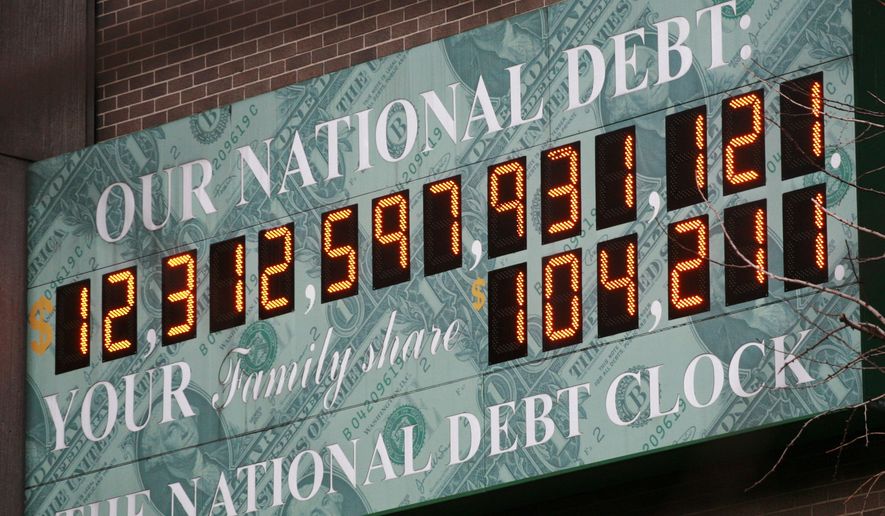Basic government spending rose by 9 percent in fiscal 2010, driving the country to a $1.291 trillion deficit down $125 billion from 2009, but still the second-largest hole on record, the Congressional Budget Office said Thursday.
CBO said the 9 percent rise in spending for defense, social programs, entitlements and interest on the debt was “somewhat faster than in recent years” a stark evaluation at a time when President Obama and Congress are working to convince voters they are pursuing a fiscally frugal course in Washington.
Still, the nearly $1.3 trillion deficit for fiscal 2010, which ended Sept. 30, is lower than prior projections, thanks in large part to expiring tax breaks, higher corporate tax receipts and the winding-down of the Troubled Asset Relief Program and payments to Fannie Mae and Freddie Mac.
“While the CBO deficit number is lower than expected, the fact that we are still in a very serious fiscal situation remains unchanged and the president is committed to getting us back on a sustainable fiscal path,” said Meg Reilly, a spokeswoman for the Office of Management and Budget.
She said the rise in non-bailout spending is largely a result of last year’s $814 billion Recovery Act, whose outlays peaked in the middle of this year and which was supporting between 1.4 million and 3.3 million jobs.
Overall, the government paid out $3.453 trillion in 2010, accounting for nearly 25 percent of the country’s gross domestic product.
That rate is well above the post-World War II average of about 20 percent, and it’s one key reason Republicans say the problem is not that government taxes too little, but that it spends too much.
“Saying no to more spending, more taxes and more debt is exactly what our constituents have been asking us to do. So we’ll keep doing it,” said Senate Minority Leader Mitch McConnell, Kentucky Republican.
But Mr. Obama, campaigning in Maryland, said Republicans spread red ink across the budget when they held the levers of power.
“They took a record surplus left by President Bill Clinton. They came back with a record deficit by the time I took office,” he said. “Now they’re out there talking about deficit reduction. We saw what you had to do with the deficit.”
CBO’s figures are a preliminary look at the government’s financial situation. The Treasury Department is expected to release the official figures next week.
The deficit is the measure of how much less the government received in revenue than it spent in a single year. The debt, meanwhile, is the total amount the government is in the hole to creditors. That figure stood at $13.625 trillion on Wednesday.
Mr. Obama has convened a commission to study ways to reduce the deficit and try to bring the debt under control. The panel is expected to make recommendations after the elections, but it’s unclear whether panel members will be able to achieve consensus and whether any of their solutions will be palatable to a bitterly divided Congress.
Lawmakers never passed a budget and left Washington without passing a single one of the dozen annual spending bills. Instead, they adopted a stopgap measure that kept the government open past Oct. 1, which marked the beginning of fiscal 2011.
That has left Mr. Obama’s goal of a net non-defense discretionary spending freeze, and his plans to cut the deficit in half by the end of his first term, in limbo.
Voters have taken note of the spreading red ink, which is one of the driving factors behind the “tea party” movement.
The nearly $1.3 trillion deficit in 2010 represented 8.9 percent of GDP.
CBO said the biggest single change from 2009 to 2010 was TARP, the Wall Street bailout, which paid out $154 billion in 2009 but actually received $108 billion in paybacks in 2010. Payments to Fannie Mae and Freddie Mac, meanwhile, dropped from $91 billion to $40 billion.
Corporate income tax receipts were up $53 billion in 2010, which CBO credited to better economic conditions and expiring tax breaks.
But individual income and payroll taxes dropped about $43 billion.
Congress was particularly generous with unemployment benefits in 2010, with payments rising from $120 billion in 2009 to $160 billion in 2010.
Defense spending grew by 4.7 percent in 2010 less than the 8 percent average in recent years while Medicare and Social Security spending also grew at about 5 percent. Federal Medicaid spending grew at 8.7 percent.
Interest on the public debt grew $26 billion, reaching $228 billion in 2010.
• Stephen Dinan can be reached at sdinan@washingtontimes.com.




Please read our comment policy before commenting.